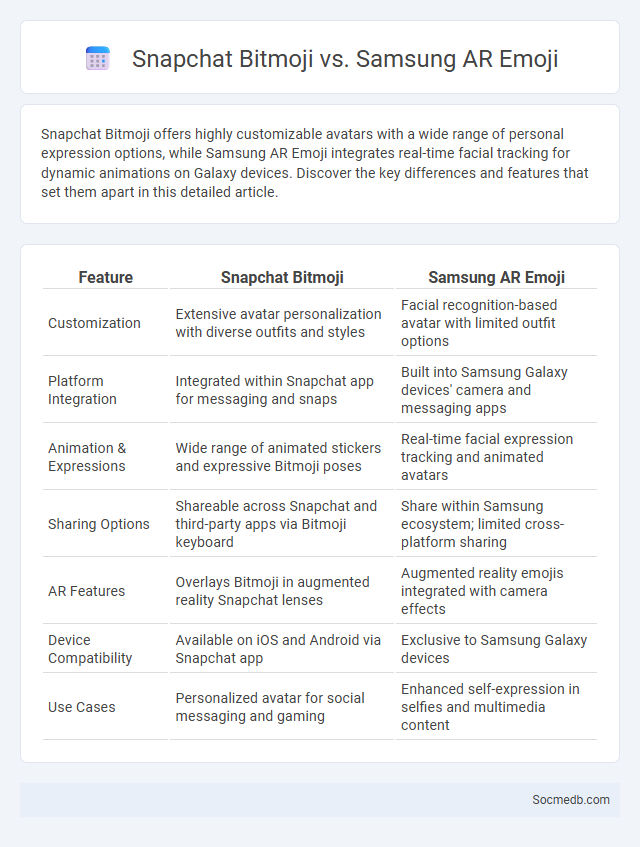
Photo illustration: Snapchat Bitmoji vs Samsung AR Emoji
Snapchat Bitmoji offers highly customizable avatars with a wide range of personal expression options, while Samsung AR Emoji integrates real-time facial tracking for dynamic animations on Galaxy devices. Discover the key differences and features that set them apart in this detailed article.
Table of Comparison
| Feature | Snapchat Bitmoji | Samsung AR Emoji |
|---|---|---|
| Customization | Extensive avatar personalization with diverse outfits and styles | Facial recognition-based avatar with limited outfit options |
| Platform Integration | Integrated within Snapchat app for messaging and snaps | Built into Samsung Galaxy devices' camera and messaging apps |
| Animation & Expressions | Wide range of animated stickers and expressive Bitmoji poses | Real-time facial expression tracking and animated avatars |
| Sharing Options | Shareable across Snapchat and third-party apps via Bitmoji keyboard | Share within Samsung ecosystem; limited cross-platform sharing |
| AR Features | Overlays Bitmoji in augmented reality Snapchat lenses | Augmented reality emojis integrated with camera effects |
| Device Compatibility | Available on iOS and Android via Snapchat app | Exclusive to Samsung Galaxy devices |
| Use Cases | Personalized avatar for social messaging and gaming | Enhanced self-expression in selfies and multimedia content |
Introduction: Personal Avatars in Social Media
Personal avatars in social media serve as unique digital representations that enhance user identity and engagement. These customizable characters enable you to express individuality, emotions, and creativity across various platforms, boosting interaction and social presence. Incorporating personal avatars can transform conventional online communication into dynamic, personalized experiences.
Overview of Snapchat Bitmoji
Snapchat Bitmoji is a personalized avatar feature allowing users to create customized cartoon representations of themselves that enhance social media interaction on Snapchat. Users can integrate their Bitmoji into snaps, chats, and stories, increasing engagement through expressive and relatable visual communication. The platform's constant updates introduce new clothing, accessories, and animations, driving user creativity and maintaining high daily active user metrics.
Exploring Samsung AR Emoji Features
Samsung AR Emoji features transform your selfies into personalized animated avatars that mimic your facial expressions with impressive accuracy. These customizable emojis can be shared across social media platforms, enhancing your digital interactions with unique, lively representations of yourself. Leveraging advanced facial recognition technology, Samsung AR Emojis offer an engaging way to express emotions and creativity in your social media posts.
What Makes Bitmoji Unique?
Bitmoji stands out in social media through its personalized avatar creation, allowing users to generate expressive cartoon versions of themselves that enhance communication. Its seamless integration with platforms like Snapchat provides a dynamic way to convey emotions and reactions beyond traditional emojis. The continuous updates and customizable features ensure users maintain a unique and relatable digital identity across various social networks.
Customization: Comparing Avatar Creation Tools
Avatar creation tools across social media platforms vary significantly in customization options, offering users a range of features from facial feature adjustments to clothing and accessory choices. Platforms like Bitmoji provide highly detailed customization including skin tones, hairstyles, and outfit styles, while simpler tools like Facebook Avatars focus on quick, user-friendly design. To make your avatar truly reflect your personality, it's essential to choose a tool that balances ease of use with extensive customization capabilities.
Integration with Social Platforms
Integration with social platforms enhances your ability to manage content, track engagement, and streamline communication across Facebook, Instagram, Twitter, LinkedIn, and TikTok. Advanced APIs and native tools enable seamless publishing, real-time analytics, and audience targeting, boosting brand visibility and customer interaction. Utilizing unified dashboards helps consolidate notifications, automate postings, and analyze cross-channel performance efficiently.
Animation Capabilities and Expression Options
Social media platforms increasingly integrate advanced animation capabilities, enabling users to create dynamic and engaging content through interactive stickers, GIFs, and augmented reality filters. These tools enhance expression options by allowing personalized animations that convey emotions and stories more vividly in posts, stories, and messages. Enhanced animation features contribute to higher user engagement and creativity, driving content virality and deeper audience connection.
User Experience and Interface Design
Optimizing social media platforms for User Experience (UX) and Interface Design enhances your engagement by providing intuitive navigation, responsive layouts, and personalized content feeds. Effective UX/UI design minimizes cognitive load, facilitating seamless interaction through clear visual hierarchy, consistent iconography, and quick load times. Prioritizing accessibility features ensures inclusive usability, broadening your audience and boosting overall satisfaction.
Privacy and Data Concerns
Social media platforms collect vast amounts of personal data, raising significant privacy concerns among users and regulators. Unauthorized data sharing and breaches expose sensitive information, undermining trust and increasing the risk of identity theft. Enhanced privacy controls and transparent data policies are essential to protect user information and comply with evolving data protection regulations like GDPR and CCPA.
Final Verdict: Which Avatar Platform Wins?
TikTok dominates as the leading avatar platform due to its extensive user base of over 1 billion active users and advanced AI-driven avatar customization features. Instagram follows closely, leveraging its integration with Facebook's AR technology and influencer economy to enhance avatar interactions. Snapchat's innovative Bitmoji and augmented reality filters maintain its niche appeal, but TikTok's combination of reach, engagement, and cutting-edge avatar tools secures its position as the top avatar platform.
 socmedb.com
socmedb.com